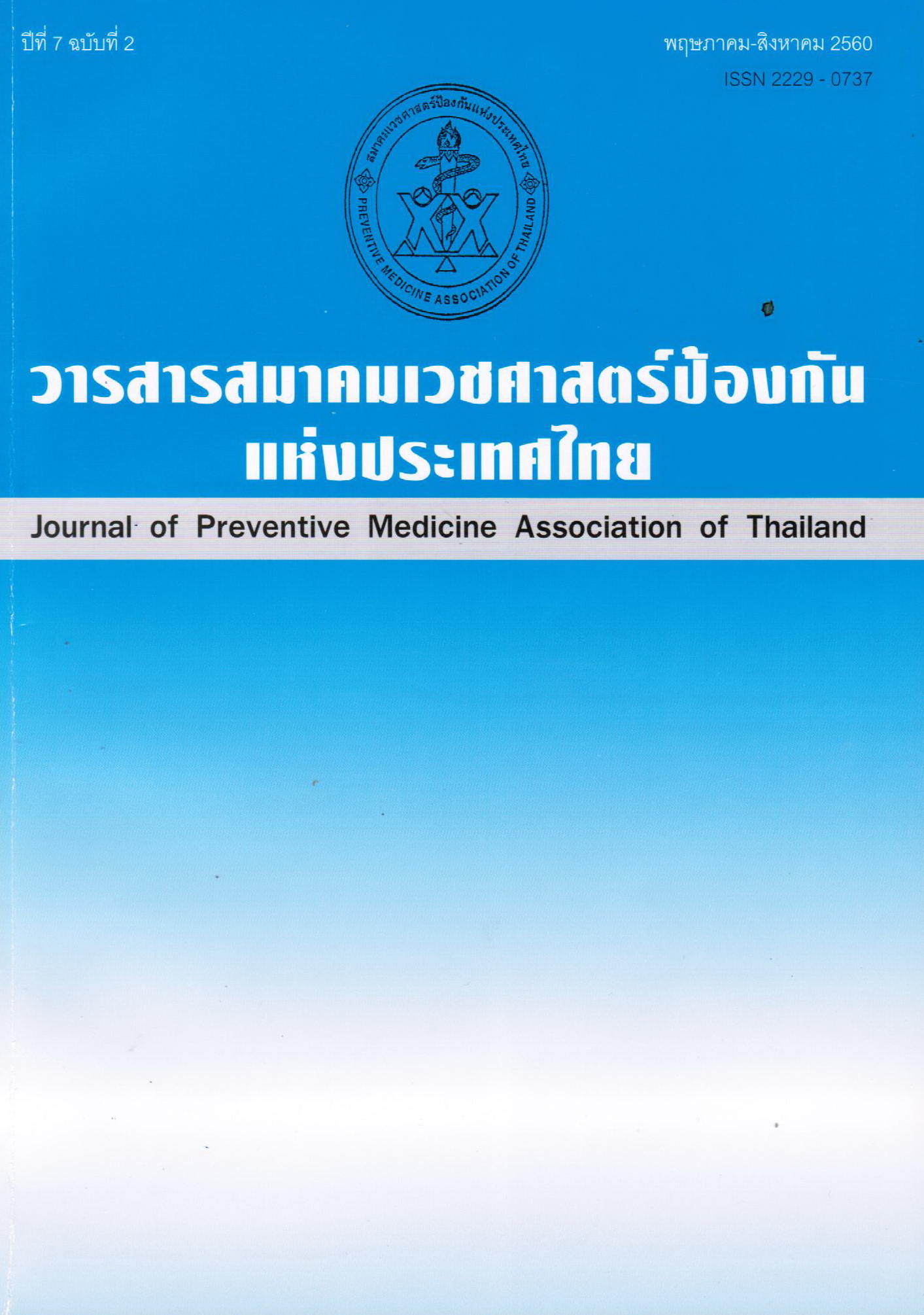Iodine Disorder Situation in Pregnant Women in Thailand During the Year 2011-2015
Abstract
Iodine deficiency disorders (IDD) is still an important public health problem in Thailand which causes consequent on intellectual disability, and affects people over all age group from fetus in womb until 3 years of age. This cross-sectional descriptive research aimed to study IDD status of pregnant woman in Thailand during 2011-2015. The data was collected from surveillance record of pregnant urinary iodine concentration in Thailand during 2011-2015, of the laboratory office, Bureau of nutrition, Department of Health. The study was performed in May 2017. Statistics were analyzed as percentage. The proportion of pregnant women whose UIC below 150 µg/L had tendency to increase from 36.5% to 53.5%. According to geographic regions: the North, Central, Northeastern and Bangkok had decreasing tendency of pregnant UIC below 150 µg/L, except region of the South had stable tendency and been above 150 µg/L. Almost all of the public health regions (PHR) had increasing tendency of pregnant UIC below 150 µg/L, except PHR-3 and PHR-8 had decreasing tendency of pregnant UIC below 150 µg/L. In conclusion, all involved sectors should set periodically campaign to provide learning about iodine nutrition in pattern of active participation for community, advocate measure of iodine supplementation in all pregnant women, support universal salt iodization included iodized salty condiments and ensuring the household coverage of iodized salt more than 90%.
References
2. Bath SC, Steer CD, Golding J, Emmett P, Rayman MP. Effect of inadequate iodine status in UK pregnant women on cognitive outcomes in their children: results from the Avon Longitudinal Study of Parents and Children (ALSPAC). Lancet 2013;382(9889):331-7. doi:10.1016/S0140-6736(13)60436-5. Epub 2013 May 22.
3. กองโภชนาการ กรมอนามัย กระทรวงสาธารณสุข. วิวัฒนาการการควบคุมและป้องกันโรคขาดสารไอโอดีนในประเทศไทย 2549. กรุงเทพฯ: องค์การสงเคราะห์ทหารผ่านศึก; 2549.
4. Wiersinga WM. The thyroid. In. Oxford Textbook of Endocrinology and Diabetes second edition. Oxford University Press Inc., Newyork : Oxford University Press Inc.; 2011.
5. WHO, UNICEF, ICCIDD. Indicators for assessing Iodine Deficiency Disorders and their control through salt iodization. Geneva: World Health Organization; 1994. WHO Document WHO/NUT/94.6.
6. สำนักโภชนาการ กรมอนามัย กระทรวงสาธารณสุข. แนวทางการดำเนินงานการควบคุมและป้องกันโรคขาดสารไอโอดีนสำหรับเจ้าหน้าที่สาธารณสุข 2558. กรุงเทพฯ:บริษัทสามเจริญพาณิชย์ จำกัด;2558.
7. สุภาภัค สิงห์เสนา, เบญจา มุกตพันธุ์. ปัจจัยที่มีผลต่อปริมาณไอโอดีนในปัสสาวะของหญิงตั้งครรภ์ที่มาฝากครรภ์. วารสารโรงพยาบาลมหาสารคาม 2558;12:3 (กันยายน-ธันวาคม):
161-172.
8. นวลรัตน์ โมทะนา, ทัศพร ชูศักดิ์, เบญจวรรณ นันทชัย, สัณวัช ไชยวงศ์. ผลการให้สุขศึกษาตามแบบแผนความเชื่อด้านสุขภาพในการป้องกันโรคขาดสารไอโอดีนในหญิงตั้งครรภ์ตำบลแม่ข้าวต้ม อำเภอเมือง จังหวัดเชียงราย. วารสารนเรศวรพะเยา 2557;7:2:178-184.
9. สุนทร ยนต์ตระกูล, ชมนาถ แปลงมาลย์. รูปแบบการพัฒนาการแก้ไขปัญหาขาดสารไอโอดีนแบบมีส่วนร่วม อำเภอเมือง จังหวัดมหาสารคาม. วารสารวิชาการสาธารณสุข 2557;23:2:
252-261.
10. อุษณา ตัณมุขยกุล, สุรสันค์ วิเวกเมธากร, ยศ ตีระวัฒนานนท์. การสำรวจการสั่งจ่ายวิตามินและเกลือแร่เสริมแก่หญิงไทยมีครรภ์. วารสารวิจัยระบบสาธารณสุข 2554;5:3 (มกราคม-มีนาคม):40-46.
11. สำนักส่งเสริมสุขภาพ กรมอนามัย. ยาเม็ดเสริมไอโอดีนสำหรับหญิงตั้งครรภ์ ใน: รายงานประจำปี 2559 สำนักส่งเสริมสุขภาพ กรมอนามัย. นนทบุรี: สำนักส่งเสริมสุขภาพ กรมอนามัย;2559.
12. สำนักอาหาร สำนักงานคณะกรรมการอาหารและยากระทรวงสาธารณสุข. รายงานความก้าวหน้าในการแก้ปัญหาโรคขาดสารไอโอดีน (พ.ศ. 2556-2558). นนทบุรี:สำนักอาหาร สำนักงานคณะกรรมการอาหารและยา;2559.
Downloads
Published
How to Cite
Issue
Section
License
บทความที่ลงพิมพ์ในวารสารเวชศาสตร์ป้องกันแห่งประเทศไทย ถือเป็นผลงานวิชาการ งานวิจัย วิเคราะห์ วิจารณ์ เป็นความเห็นส่วนตัวของผู้นิพนธ์ กองบรรณาธิการไม่จำเป็นต้องเห็นด้วยเสมอไปและผู้นิพนธ์จะต้องรับผิดชอบต่อบทความของตนเอง






